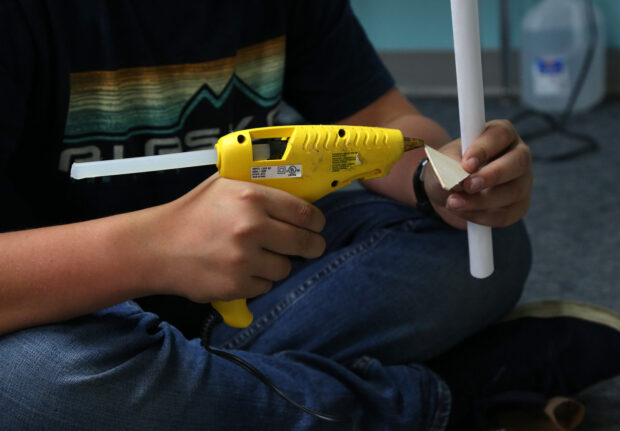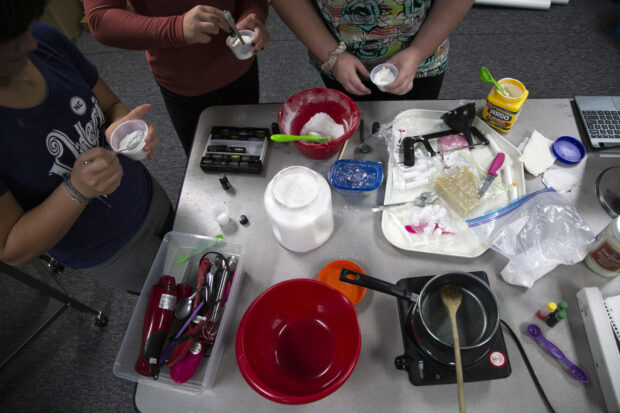The Boise School District’s 20-year oversight of Anser Charter School is coming to an end amid concerns over diversity and the small charter’s plans for transformation.
Early this week, Anser’s board of directors voted to move authorization for the charter from the Boise district to the Idaho Public Charter School Commission in the summer of 2020. Anser leaders say the move will give the school more autonomy as it pushes forward with plans to grow its Garden City facilities and add 300 students by 2025.
On Thursday, after Idaho Education News reached out for comment about Anser’s departure, the Boise School District sent out a public statement saying the district has been “increasingly concerned about the lack of student diversity at Anser.”
The school has far fewer low-income students than the Boise School District, and fewer students of color — a trait that many charter schools share.
Heather Dennis, organization director at Anser, said increasing diversity is a key part of the school’s expansion, a plan that includes both a physical transformation and an educational one.
“Our hope is to expand our school to be serving additional, and underserved communities in a way that has been a challenge for us,” she said.
Boise’s oldest charter
In the 1990’s, former Garfield Elementary School principal Darrel Burbank asked parents and staff to help him design a “dream school,” which eventually became the blueprints for Anser.
The Boise School District initially shot down the idea for an alternative to the traditional public school model, according to the Anser website. But, when Idaho opened the door for charter schools in 1998, Anser’s leaders got their chance.
The school opened its doors in September 1999 as the first charter authorized by the Boise School District. This summer, Anser will switch oversight to the Idaho Public Charter School Commission, a state body that regulates charters that don’t belong to a school district.
Nichoel Baird Spencer, president of Anser’s community board, said the move allows the school to manage special education programming internally and eventually add Pre-K and 9th grade, a plan she says the district wasn’t always on board with.
“One of the big advantages of moving…is that ability to build a program that has the same mission and values as we have, versus trying to translate our values to the Boise District to get the programming done,” Spencer said.
In a news release, Boise School District public affairs officer Dan Hollar wrote:
“Irrespective of who charters Anser, the question remains how will Anser address the issues of providing equal access to all students,” Hollar wrote.
Boise School District: 75% White, 50% Free and Reduced Lunch, 12% students with disabilities
Anser Charter School – 84% White, 19% free and reduced lunch, 10% students with disabilities
Roosevelt Elementary School (BSD) – 87% White, 17% free and reduced lunch, 9% students with disabilities
Liberty Elementary School (BSD) – 83% White, 19% free and reduced lunch, 16% students with disabilities
Dennis said the school hired a community engagement coordinator this year, specifically to recruit students from underserved populations. Next year, the school is offering free busing to reduce barriers to attendance.
Hollar also criticized Anser’s stance that the school outperforms the Boise School District.
Test data shows that Anser does outperform district scores overall, but not at every school. Some Boise elementaries with similar demographics – including Roosevelt and Liberty elementary schools – outpaced Ansers most recent test scores.
Anser does consistently outperform the state’s average scores, and is recognized as a model school for expeditionary learning, a strategy that emphasizes service, adventure and student character building.
Anser’s next steps
Four years ago, staff at Anser started to notice a problem.
Teachers were seeing an increase in anxiety and depression among adolescent students in sixth, seventh and eighth grades. At the same time, student engagement was starting to slip.
“Things that had been successful in the past were not working anymore,” Dennis said. “We realized we needed to do things differently.”
Anser students are not alone in facing mental health challenges. Jean Twenge, a professor of Psychology at San Diego State University, says teen suicide, depression and unhappiness have surged in the U.S. in the last decade.
Experts cite access to smart phones and social media as a contributor, but also point to environmental factors.
Kids are “growing up in environmental volatility, where schools have lockdowns, where there are wars across borders,” Temple University psychologist Philip Kendall told the Washington Post. “We used to have high confidence in our environment — now we have an environment that anticipates catastrophe.”
Dennis would add climate change and economic uncertainty to the list. It’s possible that 65 percent of school children will have jobs in the future that simply don’t exist today, the World Economic Forum reported in 2016.
“When you think about how school, in a traditional setting, looks almost the same as it did 150 years ago, I don’t understand how that’s preparing anyone for the future,” Dennis said.
So, for the past few years, Dennis and other members of the Anser team have been researching what could prepare students for the future.
Over time, Dennis thinks that becomes “less and less about content and knowledge.” Every student has a smart-phone at the tip of their fingers, she said, and can look up dates and figures in seconds.
“Children need the adults around them in school in a different way,” Anser principal Michelle Dunstan said. “We are not the information givers we once were.”
Instead, Dennis said, kids need to learn about processes. They need to learn about historical context for events, instead of memorizing dates. They need to know how to collaborate, evaluate their sources of information and adapt to new challenges.
How is Anser going to teach those skills? By giving students more control.
Anser is leaning into it’s student-led adventure and service oriented model, offering students more say in what they learn and how they learn it. Students will still learn a curriculum aligned to Idaho’s core standards, but educators will help focus more on helping students with how to learn, instead of always what to learn.
For example, in years past, students did photojournalism projects along the Greenbelt, documenting and capturing what they saw. But last year, students had to pitch and control their own projects, down to arranging transportation and solving problems when some rides fell through.
Other changes include:
- Longer class periods to allow more time for independent learning.
- A new self-directed elective option.
- “Flex-Friday,” devoted to fieldwork, so it doesn’t cut into other classes.
- Student self-care options, like allowing students to arrange their seating in class or allowing a few minutes of class time to decompress.
Anser administrators plan to measure success by evaluating student quality of work, feedback from parents and students, and in-house assessments that track character traits like responsibility, compassion and perseverance.
Sheri Gress, who has an eighth grade daughter at the school, said she has started to see a shift play out as Anser pilots its new learning model.
Gress, like most Anser parents, volunteers at the school. In past years, Gress has helped with electives classes. While Anser has some neat options – like fly-fishing – kids didn’t always love what they were doing, Gress said, and it showed.
This year, about a third of Anser’s 100-plus middle school students designed their own electives course.
“Where they’re choosing not just what they’re studying, but how they’re studying it now, every time I go in there they’re all lit up,” Gress said. “They’re excited about what they’re doing.”


That autonomy does carry some challenges, Gress said. Students could bite off more than they can chew. Projects won’t always work out. But she expects Anser will help the kids set realistic parameters for their project goals.
“If you want kids to be empowered, you have to give them real power,” said teacher Richard Incorvia, who supervises independent electives.
During a recent class period, Incorvia’s students edited video game footage on computers, glued fins to homemade model rockets and evaluated the design scheme and cost of a PVC and plywood boat.
Incorvia says the projects allow for “authentic” learning. Kids are preparing themselves for life after school by doing projects with real-world value and learning from their successes and failures. They retain information better when they’re doing something they care about.
Toward the end of the class period, he helped deliver one of those real-world lessons.
At the back of the class, three girls were testing a recipe for bath bombs that they hope to market and sell to local beauty suppliers.
As seventh grader Finley Linenberger dropped her bomb in a bowl of water, Incorvia watched as it fizzed, and told Linenberger to touch the bath bomb as it dissolved. Was it cold?
That’s an “endothermic reaction,” he told her. “The reaction takes heat from the environment to make it go.”
Eighth grader Cecilia Burton tested her bomb next.
“Oh yeah, that’s cold,” she said. Pulling her hand out of the water she made an equally important discovery.
The group should be cautious with food coloring in their bath-bombs, she said. Her hand was stained blue.
